Top Rankings
Gorham Randolph Shelburne Cooperative School District ranks among the top 20% of public school district in New Hampshire for:
Category
Attribute
Student Attention
Lowest student:teacher ratio (Top 1%)
For the 2025 school year, there are 2 public elementary schools serving 231 students in Gorham Randolph Shelburne Cooperative School District. This district's average elementary testing ranking is 5/10, which is in the bottom 50% of public elementary schools in New Hampshire.
Public Elementary Schools in Gorham Randolph Shelburne Cooperative School District have an average math proficiency score of 43% (versus the New Hampshire public elementary school average of 41%), and reading proficiency score of 51% (versus the 49% statewide average).
Minority enrollment is 8% of the student body (majority Hispanic), which is less than the New Hampshire public elementary school average of 18% (majority Hispanic).
Overview
This School District
This State (NH)
# Schools
3 Schools
368 Schools
# Students
370 Students
107,278 Students
# Teachers
40 Teachers
9,553 Teachers
Student : Teacher Ratio
9:1
9:1
District Rank
Gorham Randolph Shelburne Cooperative School District, which is ranked within the bottom 50% of all 189 school districts in New Hampshire (based off of combined math and reading proficiency testing data) for the 2021-2022 school year.
The school district's graduation rate of 90% has stayed relatively flat over five school years.
Overall District Rank
#111 out of 189 school districts
(Bottom 50%)
(Bottom 50%)
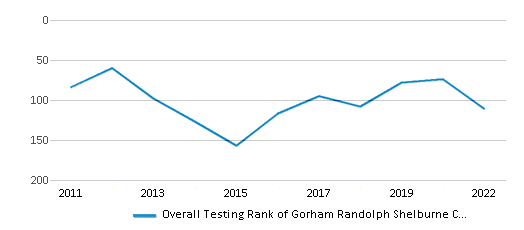
Math Test Scores (% Proficient)
41%
40%
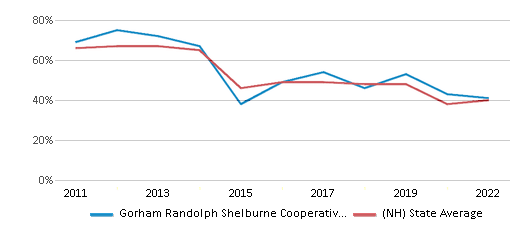
Reading/Language Arts Test Scores (% Proficient)
50%
51%
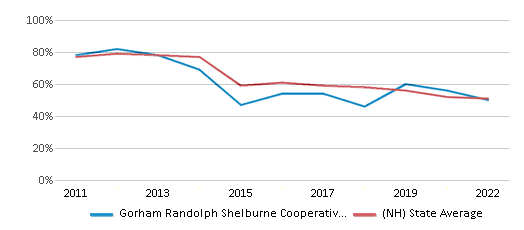
Science Test Scores (% Proficient)
35-39%
36%
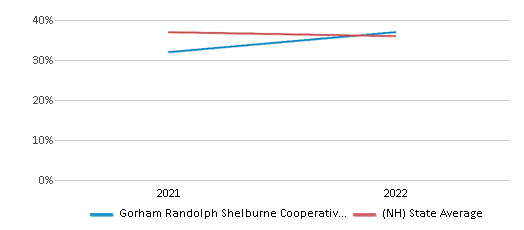
Graduation Rate
≥90%
88%
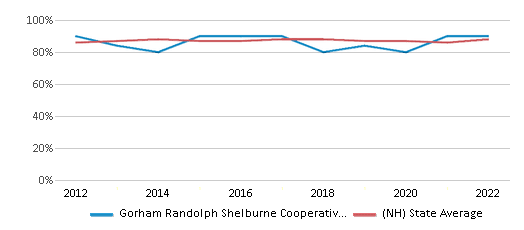
Students by Ethnicity:
Diversity Score
0.17
0.32
# American Indian Students
n/a
182 Students
% American Indian Students
n/a
n/a
# Asian Students
6 Students
3,091 Students
% Asian Students
2%
3%
# Hispanic Students
16 Students
8,138 Students
% Hispanic Students
4%
8%
# Black Students
2 Students
2,232 Students
% Black Students
n/a
2%
# White Students
336 Students
87,889 Students
% White Students
91%
82%
# Hawaiian Students
n/a
74 Students
% Hawaiian Students
n/a
n/a
# Two or more races Students
10 Students
5,673 Students
% of Two or more races Students
3%
5%
Students by Grade:
# Students in PK Grade:
-
3,041
# Students in K Grade:
19
10,416
# Students in 1st Grade:
25
11,733
# Students in 2nd Grade:
33
12,179
# Students in 3rd Grade:
20
12,078
# Students in 4th Grade:
28
12,182
# Students in 5th Grade:
22
12,522
# Students in 6th Grade:
28
11,957
# Students in 7th Grade:
29
10,676
# Students in 8th Grade:
27
10,354
# Students in 9th Grade:
40
36
# Students in 10th Grade:
35
41
# Students in 11th Grade:
34
28
# Students in 12th Grade:
30
35
# Ungraded Students:
-
-
District Revenue and Spending
The revenue/student of $22,816 is higher than the state median of $22,075. The school district revenue/student has stayed relatively flat over four school years.
The school district's spending/student of $24,503 is higher than the state median of $21,293. The school district spending/student has stayed relatively flat over four school years.
Total Revenue
$8 MM
$3,646 MM
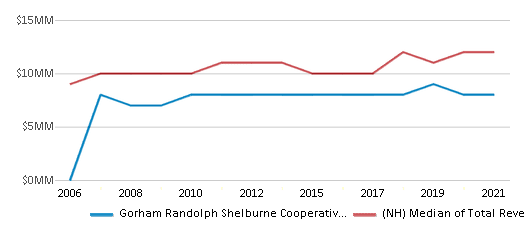
Spending
$9 MM
$3,517 MM
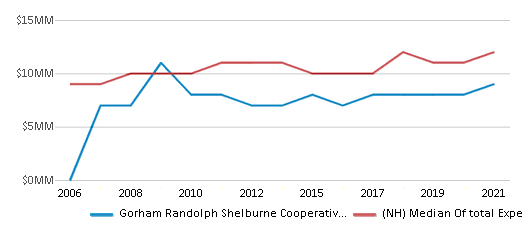
Revenue / Student
$22,816
$22,075

Spending / Student
$24,503
$21,293

Best Gorham Randolph Shelburne Cooperative School District Public Elementary Schools (2025)
School
(Math and Reading Proficiency)
(Math and Reading Proficiency)
Location
Grades
Students
Rank: #11.
Edward Fenn School
(Math: 50-54% | Reading: 55-59%)
Rank:
Rank:
8/
Top 30%10
169 Main St.
Gorham, NH 03581
(603) 466-3334
Gorham, NH 03581
(603) 466-3334
Grades: K-5
| 147 students
Rank: #22.
Gorham Middle School
(Math: 35-39% | Reading: 45-49%)
Rank:
Rank:
5/
Bottom 50%10
120 Main St.
Gorham, NH 03581
(603) 466-2776
Gorham, NH 03581
(603) 466-2776
Grades: 6-8
| 84 students
Recent Articles

Teaching: Contract Renewal
We offer a guide for teachers facing contract renewal, offering practical advice on demonstrating value, maintaining professional relationships, and ensuring successful contract renewal in public schools.

What Is A Charter School?
Explore the world of charter schools in this comprehensive guide. Learn about their history, how they operate, and the pros and cons of this educational innovation. Discover key facts about charter schools, including admission policies, demographics, and funding, as well as what to look for when considering a charter school for your child.

February 05, 2025
Understanding the U.S. Department of Education: Structure, Impact, and EvolutionWe explore how the Department of Education shapes American education, from its cabinet-level leadership to its impact on millions of students, written for general audiences seeking clarity on this vital institution.





